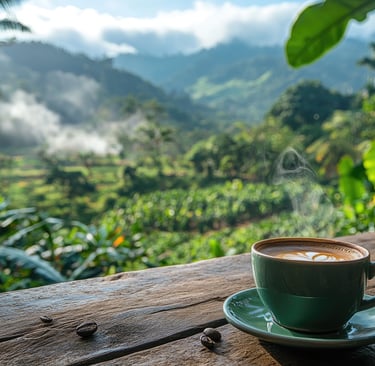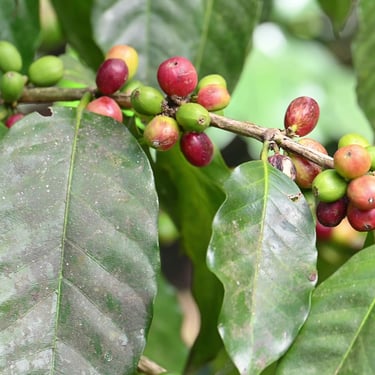Coffee in the Dominican Republic: From Bean to Cup
Discover how coffee is made in the Dominican Republic, from farms to cafés. Visit coffee plantations, explore famous brands, and taste authentic Caribbean flavor.
FOOD & DRINK ADVENTURES
11/3/20256 min read


If you love coffee, the Dominican Republic is one of the best places to visit in the Caribbean. In the mountain regions of Jarabacoa, Barahona, and Ocoa, local farmers cultivate beans that give Dominican coffee its rich aroma and smooth taste. Here you’ll discover how coffee is made from bean to cup, where to visit authentic plantations and cafés, and how to enjoy it during your trip. You’ll also find the best local brands to try and tips for bringing home the perfect Dominican coffee.
The History and Story Behind Dominican Coffee
Coffee has been part of life in the Dominican Republic for more than 300 years. Spanish settlers brought the first plants in the early 1700s, and farmers soon learned the mountain soil, steady rain, and cool air were ideal for growing them. Coffee became a daily staple, served at breakfast tables, roadside kiosks, and small cafés across the island.
Most Dominican coffee still comes from small family farms that keep traditional methods alive. Ripe red cherries are picked by hand, dried under the sun, and roasted in small batches that release a deep, fresh aroma. Many farms grow Arabica varieties such as Typica, Caturra, and Catuaí under tall shade trees, which protect the soil and help beans develop a smooth, balanced taste.
Key regions include Jarabacoa, Barahona, Ocoa, and Juncalito. Farms typically sit between 600 and 1,500 meters above sea level. The harvest runs from November to May, when families work together to collect cherries and prepare them for drying. If you visit during this season, you can join a farm tour, meet producers, and taste beans roasted on site while learning how each step shapes flavor.
Types and Flavors of Dominican Coffee
Most coffee grown in the Dominican Republic comes from Arabica, a species known for its smooth taste, gentle aroma, and lower caffeine content compared to Robusta. Arabica thrives in cool mountain climates, which is why Dominican farms are often found at higher elevations. The result is coffee that’s naturally sweet, mild, and full of flavor rather than bitterness.
Several Arabica varieties grow across the island, each bringing its own character to the cup. Typica is the oldest and most traditional. It grows in the highlands and produces a clean, smooth taste with light acidity and notes of cocoa and nuts. Caturra, a natural mutation of Bourbon, offers a brighter flavor with hints of fruit and caramel. Catuaí, a cross between Caturra and Mundo Novo, is known for its balance and soft aroma. Some farms also cultivate Bourbon Red and Pacas, which produce richer coffee with a fuller body and a gentle sweetness.
Each region adds something unique. Barahona, in the southwest, is known for deep, chocolate-like coffee with a velvety texture. Jarabacoa, in the central mountains, produces beans with caramel tones and balanced acidity. Ocoa and Baní, in the south, are known for lighter, easy-drinking coffee, while Juncalito, in the north, has cooler air that creates a touch of fruitiness in the beans.
Processing methods also shape the taste. Most Dominican farms use the washed process, where beans are cleaned and sun-dried to create a clear and consistent profile. Some small producers use honey or natural processing, letting part of the fruit dry on the bean for a sweeter, more aromatic flavor. The smell of freshly drying beans under the Caribbean sun is part of what makes coffee farming here so memorable.
Shade-grown cultivation remains an important local practice. Coffee plants grow beneath fruit and forest trees that protect the soil, preserve biodiversity, and slow the ripening process. This care helps the beans develop their signature smooth and balanced flavor.
When choosing Dominican coffee, look for beans labeled high-altitude, shade-grown, or washed Arabica from regions like Barahona or Jarabacoa. These signs usually indicate careful farming and high quality. Each cup reflects the landscape, the growers’ dedication, and the island’s long coffee tradition.




How Dominican Coffee Is Made
Dominican coffee is still made using traditional methods passed down through generations. It begins on the farm, where ripe red coffee cherries are picked by hand to make sure only the best ones are chosen.
After harvesting, the beans are separated from the fruit. Most producers use the washed process, soaking and cleaning the beans before drying them in the sun. Some prefer the natural process, leaving the whole cherries to dry first for a sweeter, fuller flavor.
Once the beans are dry, a thin outer layer is removed, revealing the green coffee beans ready for roasting. Many farms roast small batches on-site, filling the air with the smell of fresh coffee. Light roasts bring out delicate, fruity notes, while darker roasts create a stronger, richer taste.
The roasted beans are ground and brewed using classic Dominican methods such as the greca, a stovetop espresso maker found in nearly every home, or the colador, a simple cloth filter used for slow, aromatic brewing. These methods highlight the natural smoothness and flavor of Dominican coffee.
How to Enjoy Coffee During Your Trip to the Dominican Republic
1. Visit a Coffee Plantation
In Punta Cana, the Monkeyland and Plantation Safari Tour is one of the best experiences for coffee lovers. You visit a working coffee and cacao farm, walk through the fields, and see the roasting up close before enjoying a cup straight from the pot. You also meet the friendly monkeys that live nearby and explore the beautiful countryside. It is a must for anyone who wants to experience authentic Dominican life. Book your spot early because this tour fills up quickly during the busy season.
In Puerto Plata, the Mofongo, Coffee and Beach Experience combines three Dominican favorites in one day. You visit a rural home to learn how coffee is brewed the traditional way, taste it with homemade food, then make mofongo before relaxing by the sea. Reserve your tour today to experience real Dominican culture and local coffee at its best.
Try Local Cafés
Dominican coffee is best enjoyed fresh, and the island has many small cafés that take pride in their beans. In Santo Domingo, Casa Barista & Co. serves locally roasted coffee brewed in several styles, while Affogato Café offers espresso and desserts.
In Punta Cana, Café Santo Domingo in Blue Mall and Downtown Center serves the country’s most popular brand, and Dalia’s Café & Bakery is known for excellent pastries and quality local coffee.
Enjoy Coffee at Your Resort
Many all-inclusive resorts now serve Dominican coffee at breakfast and in their cafés. Ask if they use local brands such as Café Santo Domingo or Monte Alto. Some resorts also organize small tastings.
FAQs About Dominican Coffee
Is Dominican coffee strong?
Yes, Dominican coffee is known for its robust flavor and strength. It is typically brewed strong and often enjoyed with sugar.
What are some famous Dominican coffee brands?
Some well-known Dominican coffee brands include:
Café Santo Domingo: This is the most popular brand in the Dominican Republic, loved for its strong, dark flavors and suitability for espresso.
Café Monte Alto: Grown in the Jarabacoa region, this coffee is praised for its excellent taste.
Café Induban: Another prominent brand known for its quality coffee products.
Where is the best place to buy Dominican coffee?
The best place to buy Dominican coffee is at a coffee plantation, where you can taste it fresh and buy beans straight from the source. Book a plantation tour to enjoy the full experience and bring home authentic Dominican coffee.
You can also find great options at supermarkets such as La Sirena, Nacional, and Jumbo, which offer local brands like Café Santo Domingo, Monte Alto, and Induban at fair prices.
How much coffee can I bring home?
There are no strict limits on how much coffee you can bring, but it should be for personal use. If you’re traveling to the U.S. or Canada, bringing coffee is allowed with no special restrictions.
Can I take coffee in my carry-on?
Yes! You can bring roasted coffee beans or ground coffee in your carry-on or checked luggage. However, if it’s ground coffee over 12 ounces (350 ml), security might ask you to take it out for screening.
If you liked this guide, keep exploring the flavors of the island. Check out our pages on Dominican cigars and Mamajuana, two other traditions that share the same rich culture and passion as Dominican coffee.
Explore the Dominican Republic with DR Simplified – Your Viator Travel Shop
Find the best excursions, cultural experiences, and adventure tours across the Dominican Republic. From sunny beaches and waterfalls to charming towns and outdoor activities, our Viator shop makes planning your trip simple and fun. Start enjoying the best of the island.
Terms and Conditions © All rights reserved 2025
Affiliate Disclaimer
Some links on DR Simplified are affiliate links. If you make a purchase or booking, we may earn a commission at no extra cost to you. Thanks for your support!



